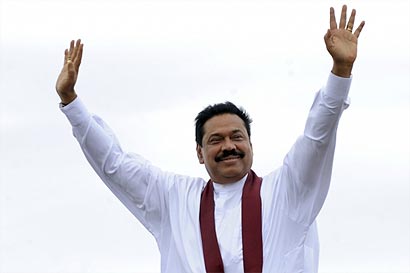President Rajapaksa Leaves for Bahrain

President Mahinda Rajapaksa left for Bahrain this morning on a two-day state visit. This is the President’s first visit to the country.
During the tour, the President will hold bilateral discussions with His Majesty King Hamad bin Isa Al-Khalifa, the King of Bahrain, and the two countries are also scheduled to sign several memorandums of understanding on a number of different sectors.
The President is being accompanied by a business delegation and will attend a meeting between Sri Lankan and Bahraini business communities.
As is customary, President Rajapaksa will also meet with the Sri Lankan community in Bahrain before conclusion of the visit.
The kingdom of Bahrain is a small island state situated near the western shores of the Persian Gulf. In addition to being an oil rich country it has heavily invested in the banking, finance and tourism sectors. The country’s capital Manama is home to many large financial structures. In recent times Bahrain has been rated as one the fast growing economics in the Arab world.
Formal diplomatic ties between Sri Lanka and Bahrain were established in 1992.
(President Media)

Latest Headlines in Sri Lanka
- Popular rapper Shan Putha arrested with firearm March 14, 2025
- Batalanda commission report tabled in Sri Lankan Parliament March 14, 2025
- Female Grama Niladharis withdraw from night duty over security concerns March 14, 2025
- Sri Lanka ranked as the best country for settling down March 14, 2025
- UN pledges support for Sri Lanka’s industrial and SME development March 13, 2025



MR may not have the crown given by the West. But he seems to be doing the right thing for the country. Considering a 30 year war ended just bit more than 3years ago, I am quite impressed by the report in Reuters website below.
(Reuters) – (The following statement was released by the rating agency)
Fitch Ratings has affirmed Sri Lanka’s Long-Term Foreign and Local Currency IDRs at ‘BB-‘. The issue ratings on Sri Lanka’s senior unsecured foreign and local currency bonds are also affirmed at ‘BB-‘. The Outlooks on the Long-Term IDRs are Stable. The Country Ceiling is affirmed at ‘BB-‘ and the Short-Term Foreign Currency IDR at ‘B’.
KEY RATING DRIVERS
Sri Lanka’s ‘BB-‘ IDRs reflect the following key rating drivers:
– Real GDP growth is relatively high and less volatile compared with its peers. The five-year average of 6.7% compares well with the 3.6% median for peers in the ‘BB’ rating category (sovereigns rated ‘BB-‘, ‘BB’ and ‘BB+’). Fitch expects real GDP growth to stabilise in 2014 at the recorded 7.3% in 2013 and to rise to 7.5% in 2015. A pick-up in tourism will continue to support growth.
– Official data do not point to overheating of the economy, as inflation (4.2% in March) and credit growth (4.4% in February) are low. However, average inflation over the past five years has been high (6.2%) and volatile compared with peers (5.0% median for the ‘BB’ peer group) and the potential for a build-up of future imbalances exists. The authorities’ pro-growth bias is illustrated by persistent “twin deficits” and easing monetary policy measures since December 2012, even at high real GDP growth levels.
– The public finances are weak relative to peers despite fiscal consolidation. Both the budget balance (-5.9% of GDP in 2013) and government debt burden (78.3% of GDP in 2013) are more than double the ‘BB’ category medians of -2.7% and 35.9% of GDP, respectively. The 2014 budget signals commitment to medium-term debt reduction to maintain a gradual fiscal consolidation path, although the process is slow and to a large extent built on revenue projections that may turn out too optimistic.
– The current account deficit has fallen from 6.7% of GDP in 2012 to 3.9% in 2013 and is expected by Fitch to narrow further to 3.2% by 2015 due to solid income from tourism and remittances. Nonetheless, the current account deficit remains persistent and is only for a relatively small part financed by FDI inflows, which are relatively low. Hence, net external debt (45.1% of GDP in 2013) is almost triple the ‘BB’ peer category median of 15.9% of GDP. External liquidity is weak, as illustrated by a low liquidity ratio (84.4%) and lower foreign exchange reserves (3.6 months of current external receipts) compared with ‘BB’ peer group medians (139.5% and 4.3 months respectively).